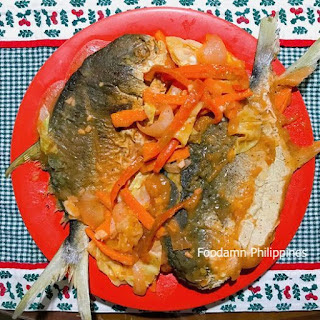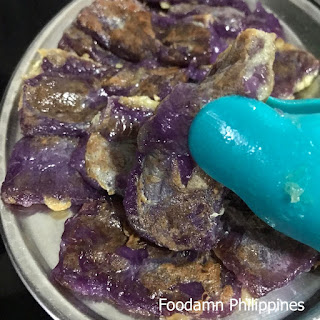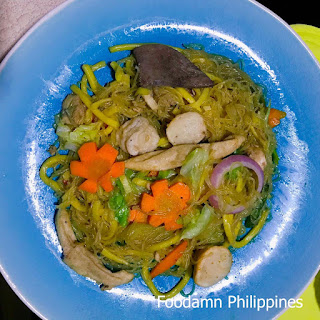- Get link
- X
- Other Apps
Chinese Lunar New Year Food Recipes and Traditions
Chinese New Year Food
Tikoy, noodles and dumplings of various kinds, usually made of glutinous rice flour, are indispensable for every household because rice is a staple food and the stickiness ensures that the family stays together. Just like Filipinos, the Chinese give a lot of importance to the New Year as a time of reunion and gathering. The stickiness and sweetness of rice cakes symbolize the wishes for a sweeter life of family members who always stick together.
Traditional food choices that are considered lucky for the Chinese Lunar New Year:
Food to prepare:
Longevity Noodles (cháng miàn)
The belief says that the longer the noodles, the luckier and healthier one will be. Here in the Philippines, noodle dishes varies from one region to another, there is great flexibility for the ingredients. We cooked and called noodle dishes in different form such as: Pancit Canton, Pancit Bihon, Miki-Bihon, Miki Guisado, Pancit Palabok, Pancit Malabon, Sotanghon Guisado, Crispy Noodle, Pancit Bato, Pancit Habhab, Pancit Molo, Batchoy, Lomi, Chicken Mami, Beef Mami, and the list goes on.
Many vegetables and meats have symbolic meanings as well.
- Lobster - endless money rolling in
- Shrimp - fortune and wealth
- Roasted pig - peace
- Duck - loyalty
- Peaches - longevity
- Tofu - happiness and fortune for the entire family
- Fish - surplus and wealth
Spring Rolls (chūn juǎn)
Eggrolls are probably the most well-known of Chinese cuisine. However, they’re actually “spring rolls. The are believed to bring wealth and good fortune owing to its shape, which resembles gold bars. These deep-fried rolls can be stuffed with various fillings. They can be made of ground pork or deboned fish like tuna. It's main components are: garlic, onions, chives or celery, bean sprouts, carrots, cabbage or other available vegetables.
Dumplings (jiǎo zi)
These can have pork, chicken, shrimp, or a combination of vegetable fillings.
 |
| Spring rolls (lumpia shanghai) and dumplings |
Whole Fish (zhēng yú)
A whole fish signifies abundance and family unity. The fish is often steamed served with a simple sauce on the side or it can be cooked as a sweet and sour.
 |
| Sweet and sour whole fish |
Whole Chicken (zhēng jī)
A while chicken symbolizes togetherness and unity, these are the family values sought during Chinese lunar new year.
Vegetable Dishes (tián yuán sù xiǎo chǎo)
"Spring is the season to plant new seeds. Traditionally, the Spring Festival is the best time to finish all the vegetables stored and preserved from the winter. This dish is a vegetarian stir-fry with mushrooms, jujube and Chinese cabbage are often included, in addition to your typical greens." (A. Xi)
Some symbolic vegetables to consider are:
Seaweed: symbolize wealth and fortune
Lotus seeds: a blessing for many children and a healthy family
Bamboo shoots: represent longevity, as well as going onward and up
Muskmelon and grapefruit: symbolize family and hope. In addition, grapefruit symbolizes wealth and prosperity
Osmanthus flower petals: in Chinese, osmanthus (guì) is a homophone, which means noble and precious
Leek/chives: leek (jiǔ) sounds similar to 久, meaning long and everlasting
Poria mushrooms: another play on words, this mushroom (fú líng) sounds similar to (fú lù), or blessings and fortune
Seaweed: symbolize wealth and fortune
Lotus seeds: a blessing for many children and a healthy family
Bamboo shoots: represent longevity, as well as going onward and up
Muskmelon and grapefruit: symbolize family and hope. In addition, grapefruit symbolizes wealth and prosperity
Osmanthus flower petals: in Chinese, osmanthus (guì) is a homophone, which means noble and precious
Leek/chives: leek (jiǔ) sounds similar to 久, meaning long and everlasting
Poria mushrooms: another play on words, this mushroom (fú líng) sounds similar to (fú lù), or blessings and fortune
Tikoy or New Year Cake (nián gāo)
"Nian Gao" is the Chinese word for this cake, meaning "higher year" which is what makes this dessert lucky. The tikoy is eaten on the first day of the year to bring better health, wealth, and happiness.
 |
| Tikoy or new year cake |
Sweet Rice Rolls
These sweet rice balls are common on CNY for good reason: the round shape signifies unity. They also represent harmony and family togetherness as the name suggest "Tang Yuan" which sounds like "reunion" Chinese (tuan yan).
Oranges and other Citrus Fruits
Oranges, pomelos, tangerines, komquats or kiat-kiat are common CNY gifts because they are believed to bring good luck and happiness, The Chinese work for "orange" and "tangerine" closely resembles the word for "luck" and "wealth". The gold color of the these fruits also symbolizes prosperity.
12 Round Fruits
"Contrary to popular belief though, putting 12 round fruits on the table for the new year is not of Chinese origin. The Chinese in the mainland put fresh food on the table, fruits and vegetables. In some regions, they put fresh flowers.
The 12 round fruits tradition most likely stemmed from a Spanish tradition of eating 12 grapes at the turn of the year, one grape for each stroke of midnight. Because we have no grapes here, maybe the Spanish of old just ate any round fruit they could get their hands on. There is, of course, no records of how and when we began this tradition, and so to the confusion of the mainland Chinese, we eat 12 round fruits and wear polka dots as symbols of luck." (Bahay Tsinoy)
Desserts and Sweets:
- Fruit Candies - for sweet happiness and on year ahead
- Candied Lotus Root - for abundance year after year
- Candied Coconut - for family togetherness and unity
- Candies Lotus Seed - for fertility and many offspring
- Candied Winter Melon - for good health and longevity
- Candied Ginger - for good health and longevity
- Candied Water Chestnuts - for family unity and togetherness
- Watermelon Seeds - for joy and fertility
- Dried Peanuts - for good health and longevity
- Dried Pineapple - for success in business
- Dried Dates - for good luck in every endeavor
- Dried Kumquats - for gold and prosperity
- Dried Longans - for many good sons
- Dried Sweet Potato - for overflowing pot of gold
- Sesame Balls - for gold and prosperity
Note that the Chinese place these sweet treats in a porcelain or plastic/lacquer plate or container with 6 or eight compartments (lucky numbers in Chinese). The number 6 symbolizes "luck" and the number 8 symbolizes "fortune". The shape of the plate or box is usually round to signify togetherness and red is the favorite color because it symbolizes joy and good luck. Each compartment is filled with your candies and nuts signifying a good wish for the New Year. In short, it is a box of blessings for an abundant life in the coming year. It is customary during the CNY to bring this tray as a gift or to serve them to guests.
Chinese New Year Dining Etiquette Do's and Don't
- Never stick your chopstick into a bowl of rice. This is considered very disrespectful as it is considered bad luck. When you stick your chopsticks upright in a bowl of rice, they look like incense sticks offered to the dead.
- Never tap your bowl with chopsticks, it's rude to the hosts.
- Always eat with your mouth closed and never slurp. In China, slurping is considered extremely rude.
- Never start eating before your host and always serve someone else first before you serve yourself.
- Never pass a piece of food to someone with your chopsticks.
- Avoid putting too much seasoning on your food. It is considered being rude to the chef.
- Do not flip the fish on one side. A turned over fish is considered bad luck. The proper way is to eat the top side first, debone, and eat the bottom side.
References:
Xi, A. Chinese New Year. Chinese New Year Dishes. https://chinesenewyear.net/food/.
Bahay Tsinoy
Maritess Allen
Villena's Kitchen
For more Foodamn Philippines home cooked recipes, visit us at Filipino Food Recipes.
Foodamn Philippines [www.foodamn.com], created by Green Dei (Daryll Villena) If you guys have tips on exotic food and recipes, write us at foodamnphilippines(at)gmail(dot)com
If you find this post helpful, informative or entertaining, feel free to SHARE it.
Follow https://twitter.com/GreenDei
Facebook Page: Foodamn Philippines
IG https://instagram.com/foodamnphilippines
YouTube https://www.youtube.com/user/DeiVille
I’d love to know what you think about this post. Feel free to leave your comment. I do reply to each of your messages or questions so please come back if you’ve left one.
Disclosure: Foodamn Philipppines receives products in order to conduct reviews. No monetary compensation was provided unless noted otherwise. All opinions are 100% my own. Some posts may contain web links in exchange for payment. In the event of a giveaway, the sponsor is responsible for delivery of the prize, unless otherwise noted in the posting. I only recommend, discuss, or introduce products/services/businesses I personally use and believe will be a good fit for my readers.

Comments
Post a Comment
[ eat me. drink me. share me. ]
Please read our complete comment policy.
We will not post comments that:
1. Promote services or products (non-commercial links that are relevant to the blog post or comment are acceptable)
2. Are simply links to other sites, blogs, editorials, etc.
3. Contain vulgar language, personal attacks of any kind, or are offensive
4. Make unsupported accusations
5. Are far off-topic